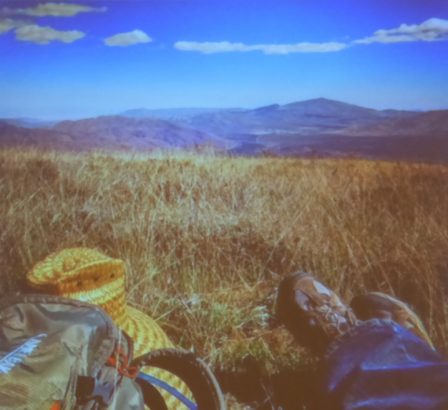Watershed Conservancy Offers Opportunity for All

Vulcan Mountain provides a focus for hikers who seek to walk and climb to the peak.
In September my eyes opened to new ideas and knowledge. Jess Norton of the San Dieguito River Valley Conservancy presented a wealth of information about her organization. Its mission is “to preserve, protect and share the natural and cultural resources of the San Dieguito River Valley through collaborative efforts to acquire lands, complete trails, restore habitats, establish educational programs, create interpretive centers, encourage recreation, and mobilize public support.” In other words, their focus is on Conservation, Recreation, and Education.
The San Dieguito River Valley Conservancy and the Friends of the San Dieguito River Valley were established in 1986. The Volcan Mountain Foundation came in 1988 and the following year the San Dieguito River Park Joint Powers Authority (JPA) was established. The JPA was formed to acquire, plan, design, improve, operate and maintain the San Dieguito River Park which consists of the County of San Diego, the cities of San Diego, Poway, Escondido, Del Mar and Solana Beach. The San Dieguito Watershed consists of about 346 square miles. The hope is to restore and enlarge it. The focused planning area is about 92,000 acres.
Within this area lives sensitive wildlife such as the San Diego horned lizard, a tiny little creature that is being starved out of its habitat by the invasion of Argentine ants. While ants are the horny toad’s primary source of food, they refuse to eat the Argentine ants. Even in laboratories our native horned lizard cannot be persuaded to eat them, but the Argentine ants are out-competing the horned lizards for the mainstay of their diet, our local ants.
Other sensitive wildlife in the San Dieguito River Park include mountain lions, American badgers and the California cactus wren whose numbers are dwindling around Lake Hodges due to habitat loss and wildfires.
In addition to losing animals, many sensitive plants are in danger as well. Jess told us the River Park is home to many threatened and endangered plant species including the federally endangered San Diego ambrosia and the Del Mar manzanita. Both delicate clarkia and barrel cactus are listed as sensitive by the California Native Plant Society.
To help conserve the watershed, San Dieguito River Valley Conservancy and San Dieguito River Park own 17 separate parcels or 3,500 acres spread across the watershed. They purchase land slated for development, housing tracts and shopping malls. They are constantly working on habitat restoration restoring more than two thousand acres, and they have raised over three million dollars in grant funding since 2003. Crews of volunteers go with experts to weed invasive plants from the area and to plant native species. The groups encourage families to participate together.
This helps conservation and education as the children learn by doing (as do the adults!)
Recreation is one of the Conservancy’s main objectives. There are maps of trails, and QR codes posted throughout the park where your cell phone can give you history or point out items you won’t want to miss. You can go on guided hikes if you like. One goal is to complete the Coast to Crest Trail, which will eventually connect the headwaters at Volcan Mountain near Julian to the mouth of the river at Del Mar North Beach. The River Park trails are multi-use and suitable for hiking, biking, and horseback riding. There are group activities available including Furry Friend hikes (on leashes, please) Exec Treks, advanced fitness hikes, riding trails, bicycle trails, furry pet walks (on leashes, please) advanced hikes — there is something for everyone.
Celebrate Valentine’s Day on Volcan Mountain. Take a Full Moon Hike. There is even a new Trails & Ales Hike Series where you hike and refresh yourself with local brews.
Education is another objective. In 2014 the Birdwing Open Air Classroom was completed. It is a trailside classroom available as a venue for outside groups. It is ADA accessible and seats 80. The Watershed Explorers Program is another educational experience.
It was launched in 2015 and has two passenger vans to take students from grade six through senior year on fieldtrips. Right now there are five separate trips and they have served over 160 students to date. Teachers can contact the Conservancy to arrange tours.
In 2014/2015 the San Dieguito Citizen Science Monitoring Program was launched. With volunteers working with trained personnel, the Conservancy can create “a sustainable, cost-effective, scientifically valid, monitoring protocol specific to the River Park. On these surveys a field botanist (either a staff member or a volunteer botanist) leads lay people as he/she identifies plants and supervises removal of weeds and invasive plants. The Palomar Audubon Society supervises the “Birders” who identify when, where, and how many various birds visit or reside. The same is done for reptiles and amphibians, and, of course, mammals. Wild life cameras are set up for capturing events and situations you would not normally see.
During the 2014/2015 program, the Sycamore Creek/San Dieguito River Park Headquarters had 150 citizen scientists attend 12 survey events where 172 plant species was noted and 93 wildlife species were observed. By mid-2016 there were 74 new citizen scientists volunteering, eight survey events, 202 plant species observed and 75 wildlife species.
Anyone can get involved. The website is www.sdrvc.org. Get the newsletter, join, “like” the Conservancy Facebook page, attend the San Dieguito River Valley Explorers Meetup Group, or become a volunteer.
February 22 the Mission Hills Garden Club will hear Andrew Danniberger speak about national guard pest products and what is safe for kids, pets and edibles. The meeting will be from 6 to 8 p.m. at the church at 4070 Jackdaw. Members are free; guests pay $10, which will be applied to their $35.00 membership if they join that evening.
Category: Education, Featured Articles







